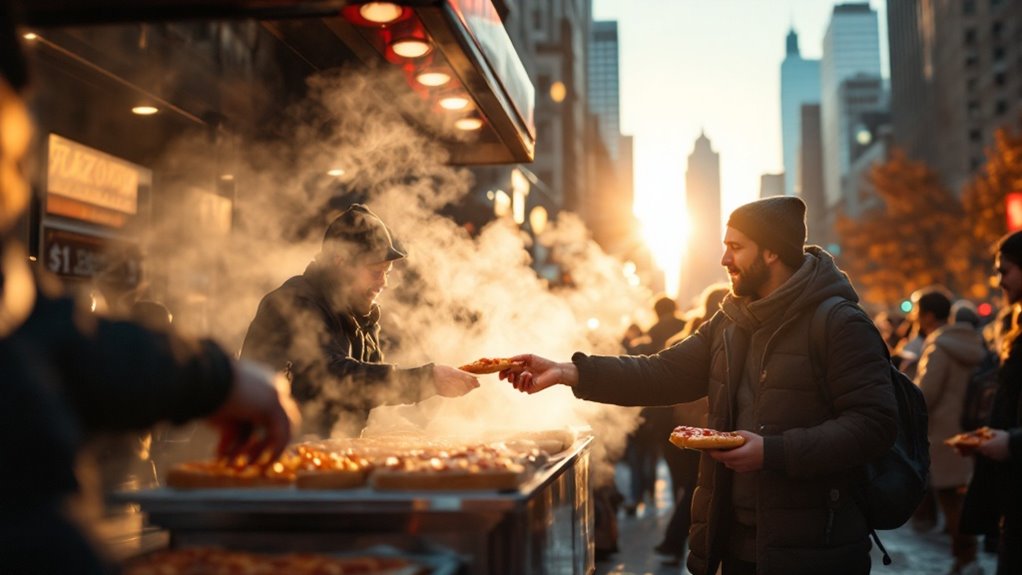New York City offers numerous ways to experience its magic without overspending. Visitors can explore free attractions like the High Line and Central Park while using money-saving strategies for accommodations in outer boroughs. A 7-day unlimited MetroCard provides efficient transit access, and budget-friendly dining options abound in ethnic neighborhoods and food halls. Smart planning and local insights reveal how the city’s greatest treasures don’t require a fortune to enjoy.
Key Takeaways
- Take advantage of free attractions like Central Park, High Line, and Staten Island Ferry to experience NYC’s iconic sights.
- Stay in budget-friendly areas like Astoria or Long Island City instead of Manhattan for significant accommodation savings.
- Purchase a 7-day unlimited MetroCard for cost-effective transportation throughout the city’s extensive subway and bus system.
- Explore affordable dining options in ethnic neighborhoods and food halls, focusing on lunch specials and street food vendors.
- Seek out pay-what-you-wish museum admissions and free walking tours to experience culture without high costs.
Free and Low-Cost Attractions That Rival Expensive Tourist Spots
Countless budget-friendly attractions in New York City offer experiences that match or surpass their pricier counterparts. The High Line, an elevated park built on former train tracks, provides stunning city views and public art installations at no cost.
While the Empire State Building charges hefty fees, the Brooklyn Heights Promenade offers equally magnificent Manhattan skyline views for free.
Cultural enthusiasts can visit the Metropolitan Museum of Art through pay-what-you-wish admission for New York residents, rather than paying the suggested $25 ticket.
Central Park’s free attractions include Belvedere Castle, Bethesda Fountain, and Shakespeare Garden, rivaling expensive botanical gardens.
The Staten Island Ferry offers close-up views of the Statue of Liberty without the expensive harbor cruise prices, complete with panoramic harbor vistas.
Smart Money-Saving Tips for Accommodation, Transport, and Dining
Savvy travelers can drastically reduce their New York City expenses through strategic planning of accommodations, transportation, and dining.
Budget-conscious visitors should consider staying in outer borough neighborhoods like Astoria or Long Island City, where hotel rates are considerably lower than Manhattan. Hostels and apartment rentals through verified platforms offer additional savings.
For transportation, purchasing a 7-day unlimited MetroCard proves more economical than individual rides, while walking and cycling provide free alternatives for shorter distances.
Food expenses can be minimized by exploring ethnic eateries in Queens and Brooklyn, visiting food halls like DeKalb Market, and taking advantage of lunch specials at upscale restaurants.
Street food vendors and farmers’ markets also offer authentic New York experiences at fraction of restaurant prices.
FAQ
What’s the Best Time of Year to Visit NYC for Cheaper Rates?
January through March offers the lowest hotel rates and airfare to New York City, excluding holidays.
Winter months see fewer tourists, resulting in better deals on accommodations and attractions.
September and October provide mild weather and moderate pricing, while avoiding peak summer crowds.
Early December can also offer decent rates before holiday season pricing takes effect in mid-month.
Is It Safe to Stay in Budget Accommodations Outside Manhattan?
Many areas outside Manhattan, particularly in Brooklyn and Queens, offer safe and affordable accommodation options.
Neighborhoods like Long Island City, Williamsburg, and Astoria are well-connected by subway and generally safe for tourists.
Visitors should research specific neighborhoods, read recent reviews, and check crime statistics. Areas near subway stations are typically safer and more convenient for accessing Manhattan’s attractions.
Which NYC Tourist Passes Actually Save Money Versus Individual Ticket Purchases?
The New York CityPASS and New York Pass offer genuine savings for tourists visiting multiple attractions.
CityPASS typically saves 40% on major sites like Empire State Building and American Museum of Natural History.
The New York Pass becomes cost-effective when used for 3+ attractions daily during its validity period.
The Explorer Pass proves economical for visitors planning 3-10 specific attractions over 30 days.
Where Can I Store Luggage Cheaply Between Hotel Check-Out and Late Flights?
With global luggage storage bookings increasing 50% annually, travelers have more affordable options than ever.
Several secure solutions exist for storing bags between checkout and flights. Luggage storage apps like LuggageHero and Bounce offer vetted locations throughout major cities, charging around $6-10 per bag daily.
Train stations, airports, and some hotels also provide storage lockers, while companies like Vertoe partner with local businesses for convenient drop-off points.
Are Street Food Vendors and Food Trucks Safe to Eat From?
Street food vendors and food trucks are generally safe to eat from when they display valid health department permits and maintain good hygiene practices.
Customers should look for cleanliness, proper food handling, and grade ratings where applicable.
Vendors who cook food to order, keep ingredients at appropriate temperatures, and have a steady flow of customers typically offer the safest options for street dining.






